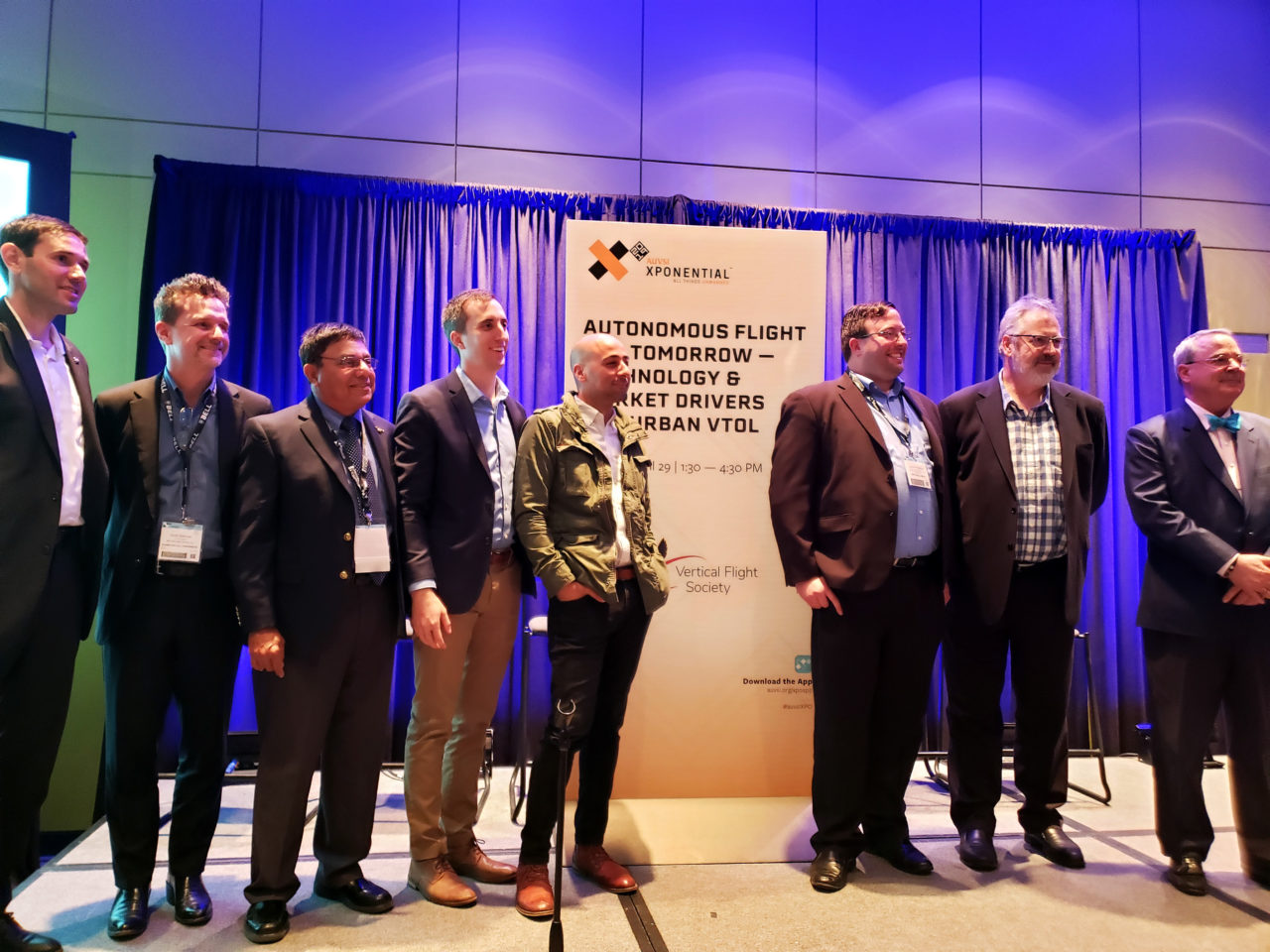
Urban air mobility panel at AUVSI Xponential 2019. (Nick Zazulia/AVI)
For urban air mobility to succeed — at scale — the industry will need to answer a question: What will it do about pilots?
Ultimately, many entrants to the air taxi game want autonomy to solve the challenge, providing safer, more reliable and more cost-effective flight without the need to pay (or develop) a workforce or use up a seat on a non-paying body. Currently, regulation doesn’t allow for that, the public might not be ready to accept an unmanned aircraft and there’s debate over how close the technology is.
Do you use pilots as a bridge to unmanned flight? Push for autonomy to be ready when it can and let the chips fall where they may for public acceptance?
If you’re Bell, which is developing its distributed-propulsion Nexus air taxi, you think pilots are a necessary evil in the short-term.
“I would like it to be autonomous right away,” said Scott Drennan, head of innovation at Bell, who suggested up to 10,000 pilots needed based on market forecasts. Drennan spoke at the Association of Unmanned Vehicle Systems International (AUVSI) Xponential conference here, on a panel sponsored by the Vertical Flight Society.
“I think the technologists could do that. But the regulatory and more importantly, because I don’t want to use regulations as a copout, the public acceptance [will be barriers]. We’re trying to do a valuation of a time machine here.”
While things are still up in the air, Drennan suggested starting with a traditional pilot occupying one of the Nexus’ five seats before moving to a mid-term state with more automation where a remote pilot is in a control center and increasing the number of vehicles that pilot can monitor at once — 10, 20, and eventually going fully autonomous.
For Bell’s part, the focus is on who those pilots are going to be and how to train them. Drennan said “future flight controls” is a big initiative within the company, using simulator technology and feedback to figure out the most intuitive way to design flight controls. The increased automation within fly-by-wire technology makes cockpit redesigns, particularly for a new vehicle segment, very possible, with a goal of making “not less rigorous, but less taxing training,” he said.
Jonathan Hartman, the disruptive technologies lead for Sikorsky Innovations, echoed some of Drennan’s major points, noting that both cars and elevators required specialized, highly trained operators when first released, before further development and public trust winnowed that down to today’s standards.
Davis Hackenberg, NASA’s advanced project manager for advanced air mobility however, thinks that’s the wrong way to approach the problem. Essentially, don’t create more costs that threaten the business model and make a need to certify more and more systems just because you want to get off the ground slightly sooner. While he made sure to mention that even within his office, which focuses on advanced air mobility, there is no consensus on the issue, he clearly favors going straight to unmanned flight.
“I really firmly believe we don’t want to start with the way industry is proposing starting some of these operations right now unless it really is the minimum viable product, trying to just get data on what happens here and what happens there,” Hackenberg said. “I don’t believe we can go through all these progressions. If you try to certify 100 different systems and make them all interoperate … I guarantee it’s not going to be that easy.”
Two market studies that Hackenberg pointed to suggest that public acceptance won’t be as much of an issue as some in the industry fear — though that isn’t always safe to trust until people have to face the reality of it, and Hackenberg noted that “an accident or two” could completely change public opinion.
“If you look at what it might actually do to the industry to go through the certifications and the approvals and the new pilot training … what it could do to that timeline, if you assume some best-case, worst-case stuff, it’s not really that pretty, Hackenberg said. “Our team spent way too much time over the last year trying to have this argument, and there was no consensus among our team, and there’s no consensus among industry.”
There may not be consensus, but Hackenberg’s side of the debate had its support: Brian Yutko, senior vice president of programs at Boeing subsidiary Aurora Flight Sciences also downplayed the problem that regulation and public acceptance pose.
“As somebody who is developing these technologies, we aren’t proposing that we do this right now,” he said. “The FAA isn’t what’s preventing us from doing it. We’re preventing ourselves by saying these systems aren’t ready and we need to develop them further… I think the consumer [acceptance] thing is a bit of a red herring to cover up for the fact that the systems aren’t ready.”
Yutko suggested that there is some acceptance shown, and while there are skeptics, they will likely come around once the value proposition is demonstrated, providing Uber as an example. It might have sounded outlandish before it was a reality, but once people saw how it could benefit them, it didn’t take too long for it to be accepted, he said.
Drennan remained entrenched, though. He said current fly-by-wire systems can handle takeoff-to-landing autonomous flight nearly on their own, so he thinks the technology is or can shortly be ready.
“We actually stripped them down to give them less capability than they’re capable of to make folks comfortable,” he said. “There’s tech that’s really close, and I think any day now we could just take our hands off fixed wing and get there if we really wanted to get there.”
He did tell Avionics International that he’s still open to starting off unmanned — it would, after all, save a ton of money — he’s just not sure it’s realistic in the near term. Suffice to say, there’s no consensus on the matter.